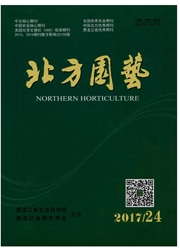

 中文摘要:
中文摘要:
以核桃坚果中内果皮和种仁(种皮、胚、子叶)提取液为试材,研究了核桃内源抑制物质对白菜与小麦种子萌发和幼苗生长的影响,比较分析了流水冲洗和温水浸泡去除抑制物质的效果。结果表明:核桃坚果中存在较强活性的内源抑制物质,其活性随提取液浓度的增大而增强,相同浓度水平时,种仁中抑制物质活性大于内果皮。溶于乙醚的抑制物质纸层析分离后在Rf1.0区段活性最强;溶于水的抑制物质纸层析分离后分别位于Rf0.1和Rf0.9区段活性最强,说明种仁中抑制物质有易溶于水的成分,也有易溶于乙醚的成分,并且水溶性物质对种子萌发和幼苗生长的抑制活性更强;流水冲洗和40℃温水浸泡可除去部分内源抑制物质。
 英文摘要:
英文摘要:
Taking walnut endocarps and seeds (seed coats, cotyledons and embryo) as materials, the effect of endogenous inhibitors on seeds germination and seeding growth of Chinese cabbage and wheat were studied,and the two methods of removing inner inhibitory substances that were soaking in warm water and washing with flowing water were compared. The results showed that there were endogenous inhibitors with higher activities in walnut seeds. And increasing of the concentration of endogenous inhibitors would enhance the inhibitory effect. The inner inhibitory substances from kernels showed stronger inhibitory effect than endocarps. The highest zone of paper chromatography of ether extraction of endogenous inhibitory substances was Rf 1.0; the highest zones of paper chromatography of remained liquid after extraction with ether were Rf 0. 1 and Rf0. 9. This demonstrated that endogenous inhibitors of walnut seeds consisted of not only ingredient easily soluble in water, but also those easily soluble in non-polar ether solvent. And water dissolved inner inhibitors showed stronger inhibitory effect on seeds germination and seeding growth. The endogenous inhibitory substances could be partly removed by soaking in warm water (40℃) or washing with flowing water.
 同期刊论文项目
同期刊论文项目
 同项目期刊论文
同项目期刊论文
 期刊信息
期刊信息
